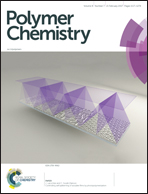A new FRET-based ratiometric probe for fluorescence and colorimetric analyses of adenosine 5′-triphosphate†
Abstract
This paper reports a new ratiometric probe for the detection of adenosine 5′-triphosphate (ATP) that is based on the binding-induced modulation of fluorescence resonance energy transfer (FRET) coupled with the aggregation-caused quenching (ACQ) sensing mechanism. The introduction of coumarin fluorophores as FRET donors into the side-chain of polythiophene (PT) as the FRET acceptor provides the ratiometric probe. Upon addition of ATP, the formation of a polymer/ATP complex leads to the conformational changes of the PT backbone from a random coil to the planar conformation and aggregation. As such, the ratiometric ATP detection can be achieved by taking advantage of spectral overlap changes to modulate the FRET efficiency from coumarin fluorophores to the PT backbone before and after the addition of ATP, coupled with ACQ. The probe exhibited a clear seesaw-type dual-emission signal change upon binding with strong affinity (Kapp = 3.12 × 104 M−1) to ATP in aqueous solution, whereas no obvious emission changes were observed with ADP, AMP or various other anions. The probe can also be utilized for naked-eye detection of ATP and real-time monitoring of the ATP hydrolysis reaction by apyrase under physiological pH conditions.



 Please wait while we load your content...
Please wait while we load your content...